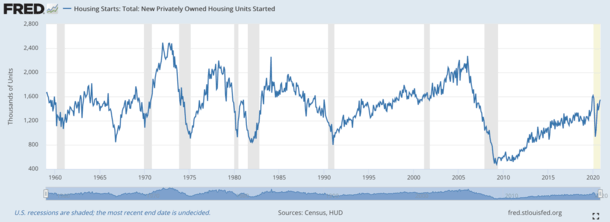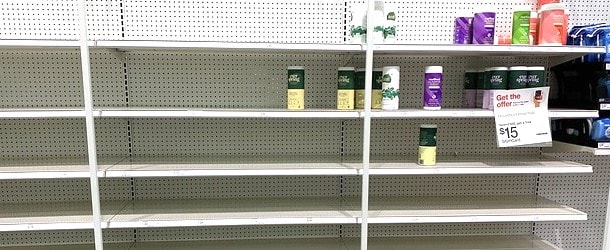To say residential real estate is on fire would be a huge understatement. In fact, it’s so popular that we’re literally running out of homes.
Simply put, there are too many home buyers and not enough properties for sale, nor is the supply being replenished fast enough.
In a way, it reminds me of the toilet paper crisis that marked the beginning of the COVID-19 pandemic in spring of 2020.
While you might hesitate to call the latest housing boom akin to panic buying, there is some bubbly sentiment in the air that is reminiscent of the early 2000s.
Back then, folks were purchasing homes sight-unseen in faraway states because mortgage financing was cheap and loan underwriting non-existent.
Today, mortgage financing is even cheaper, with mortgage rates not far off their all-time record lows.
However, mortgage underwriting isn’t what it was once, and is in fact a lot better, thankfully. If it weren’t, I’d hate to see what today’s housing market would like look.
Where Are All the Homes?
- Total housing supply (1.28 million homes) is at an all-time low, per NAR
- The current sales pace (2.3 months) is also at its lowest point in history
- Homes on the market are selling nearly twice as fast as they were a year ago
- And there are very few distressed sales with foreclosures and short sales accounting for less than 1% of the total
The National Association of Realtors recently noted that despite a monthly 2.5% decline in existing-home sales in November, transactions were up a startling 25.8% from a year earlier.
That pushed the sales pace up to a seasonally-adjusted annual rate of 6.69 million, up from 5.32 million in November 2019.
Meanwhile, total housing inventory fell from both the prior month and a year earlier to just 1.28 million.
While 1.28 million sounds like a big number, it’s only enough to last 2.3 months at the current sales pace. And both the housing supply and sales pace are at record lows.
Oh, and properties typically remained on the market for just 21 days, which was nearly half the time seen in November 2019 (38 days).
Additionally, 73% of the homes that sold in November 2020 were on the market for less than a month.
So what little is out there is going super-fast, kind of like those few rolls of toilet paper, which disappeared in the blink of an eye, even if they were one-ply or off-brand.
In real estate terms, the house that you assumed would never sell may have finally sold.
This has been welcome news for existing homeowners, as the median price increased to $310,800, up a big 14.6% from November 2019 ($271,300). It also marked 105 straight months of year-over-year gains.
We’re nearing a decade of year-over-year gains for residential real estate, which bottomed around 2012.
New Home Building Is Still Catching Up with Demand

- Home builders pumped the brakes after the housing crisis materialized a decade ago
- There was too much supply thanks to overbuilding coupled with a flood of distressed sales
- But they may have gone too far and are now playing catch-up to meet home buyer demand
- Shifting demographics have also increased home buyer appetite making the shortage even more pronounced
So we know real estate is in high demand, and that supply is dwindling. The question is why?
One issue has been a lack of home building over the past decade, while our population has continued to grow.
At the same time, those hitting (or soon to be reaching) the ripe first-time home buyer age of 34 is staggering.
Roughly 45 million Americans will turn 34 over the next decade, and many of them will want to own homes.
But if you look at home building, in terms of housing starts, it has been depressed since 2008, and though they’ve rebounded of late, it takes time for that to translate to supply.
Just look at the chart above from the St. Louis Fed and you’ll have a better understanding of why there are so few homes available.
The good news is home building is up by double-digits from a year ago. Additionally, both building permits and housing completions are up markedly.
So at some point relatively soon, there is going to be a lot more supply to meet all this demand, similar to how the toilet paper companies eventually got caught back up and shortages were no longer an issue.
What Will the Next Housing Crisis Look Like?
- Imagine a housing market with a lot more supply thanks to increased home building
- Along with a new steady supply of homes via distressed sales (short sales, foreclosures)
- Then sprinkle in mortgage rates that are higher than they had been in preceding years
- You might have a recipe for a housing market crash, or at least a pullback in prices
The big question is what happens next. Yes, supply will eventually meet demand, it’s not a matter of if but when.
As you can see from the chart, home building has ramped up a ton and will likely continue to increase over the next several years.
Eventually, we should have a balanced housing market, where it’s no longer a seller’s market, nor a buyer’s market.
However, as we’ve seen in the past, we’ll likely overshoot that period of homeostasis and wind up with oversupply.
At that point, we could be facing a scenario where there’s too much inventory coupled with higher mortgage rates, which together have the potential to drag down home prices.
To go back to my toilet paper analogy, all of a sudden the shelves are fully stocked and the companies are trying to charge top dollar. But few are interested.
Sure, the customer still wants it, but what price are they willing to pay? Or what price can they pay? And how much do they really need?
Is anyone going to buy the less desirable rolls (aka the houses that typically sit on the market)?
Throw in even more supply from a new wave of distressed sales due to unemployment, a lack of housing affordability, and likely a return to high-risk mortgage lending, and it’s easy to picture how home prices can dive again.
I don’t expect this to happen overnight, and I’ve continuously marked the year 2024 as the turning point.
Whether that happens or not remains to be seen, but I do see the current bull run in housing approaching its later innings.

